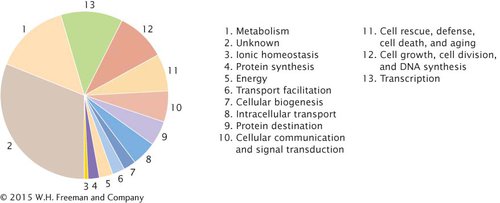Prokaryotic Genomes
Several thousand prokaryotic genomes have now been sequenced. Most prokaryotic genomes consist of a single circular chromosome. However, there are exceptions, such as Vibrio cholerae, the bacterium that causes cholera, which has two circular chromosomes, and Borrelia burgdorferi, which has 1 large linear chromosome and 21 smaller chromosomes.
GENOME SIZE AND NUMBER OF GENES The total amount of DNA in prokaryotic genomes ranges from 490,885 bp in Nanoarchaeum equitans, an archaean that lives entirely within another archaean, to 9,105,828 bp in Bradyrhizobium japonicum, a soil bacterium (Table 15.1). Although this range in genome size might seem extensive, it is much less than the enormous range of genome sizes seen in eukaryotes, which can vary from a few million base pairs to hundreds of billions of base pairs. Most prokaryotic genomes are several million base pairs in size. Escherichia coli, the bacterium most widely used for genetic studies, has a fairly typical genome size at 4.6 million base pairs. Archaea and bacteria are similar in their ranges of genome size. Surprisingly, genome size shows extensive variation within some species; for example, different strains of E. coli vary in genome size by more than 1 million base pairs.
| Species | Size (millions of base pairs) | Number of predicted genes |
|---|---|---|
| Archaea | ||
| Archaeoglobus fulgidus | 2.18 | 2407 |
| Methanobacterium thermoautotrophicum | 1.75 | 1869 |
| Nanoarchaeum equitans | 0.490 | 536 |
| Eubacteria | ||
| Bacillus subtilis | 4.21 | 4100 |
| Bradyrhizobium japonicum | 9.11 | 8317 |
| Escherichia coli | 4.64 | 4289 |
| Haemophilus influenzae | 1.83 | 1709 |
| Mycobacterium tuberculosis | 4.41 | 3918 |
| Mycoplasma genitalium | 0.58 | 480 |
| Staphylococcus aureus | 2.88 | 2697 |
| Vibrio cholerae | 4.03 | 3828 |
|
Source: Data from the Genome Atlas of the Center for Biological Sequence Analysis, http:/ |
||
Among prokaryotes, the number of genes typically varies from 1000 to 2000, but some species have as many as 6700 and others as few as 480. Interestingly, the density of genes is rather constant across all species, with an average of about 1 gene per 1000 base pairs. Thus, prokaryotes with larger genomes have more genes, in contrast to eukaryotes, for which there is little association between genome size and number of genes. The evolutionary factors that determine the sizes of genomes in prokaryotes (as well as in eukaryotes) are still largely unknown. Only about half of the genes identified in prokaryotic genomes can be assigned a function (Figure 15.9). Almost a quarter of those genes have no significant sequence similarity to any known genes in other bacteria.

CONCEPTS
Comparative genomics compares the content and organization of whole-
 CONCEPT CHECK 2
CONCEPT CHECK 2
What is the relation between genome size and gene number in prokaryotes?
Species with larger genomes generally have more genes than do species with smaller genomes, so gene density is relatively constant.